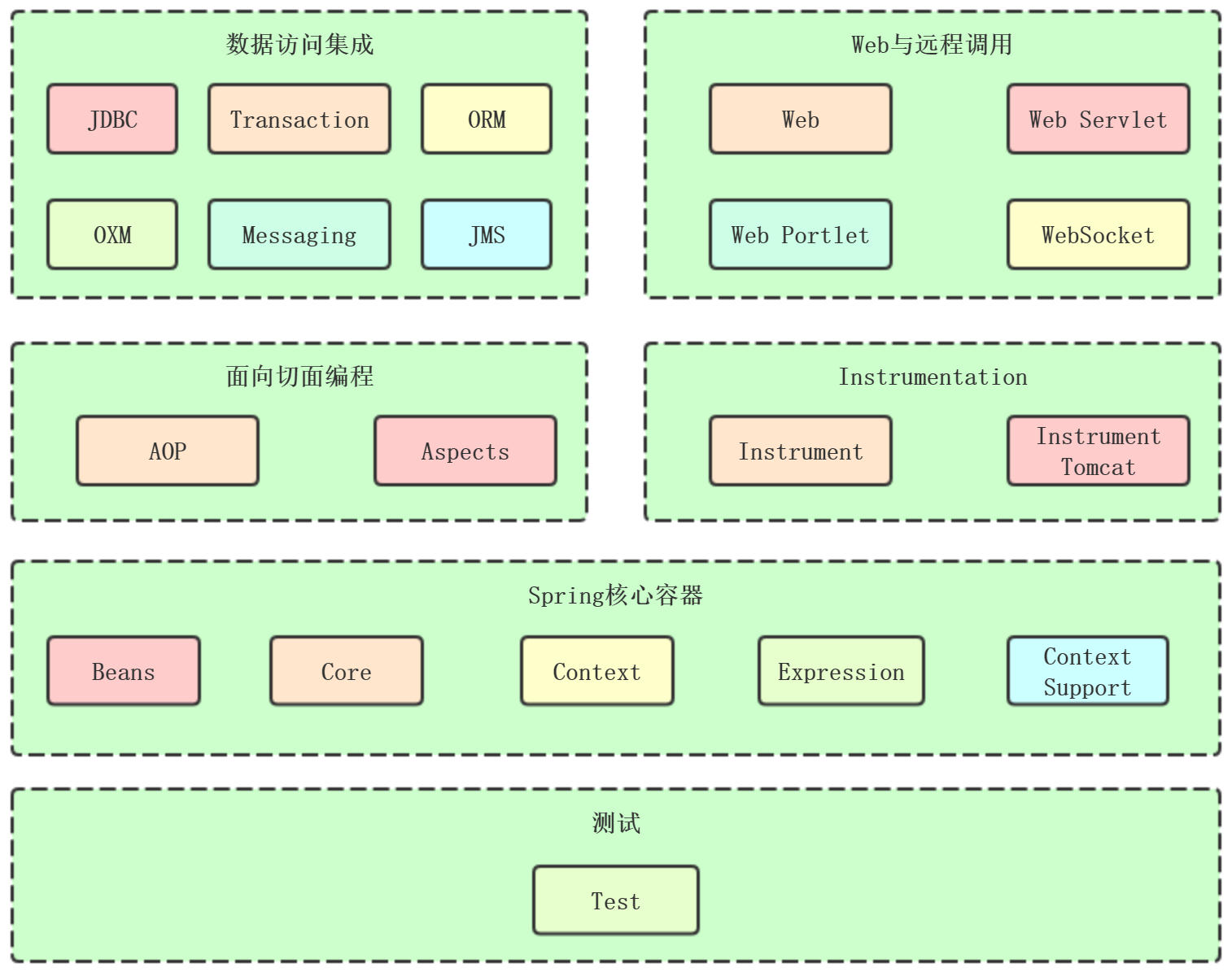企业日常开发中,几乎都是Spring系的框架,无论是SSM、还是现在大火的SpringBoot+JPA/MyBatis,使用最大的目的就是简化开发
基本模块:

核心容器:Beans、Core、Context、SpEL
1. core和beans模块提供了整个框架最基础的部分,包括了IoC(控制反转)和Dependency Injection(依赖注入)。
2. Context建立在Core和Beans模块提供的基础之上:他提供了框架式访问对象的方式
3. core、beans、context构成了Spring的骨架
4. SpEL:提供了一种强大的用于在运行时操作对象的表达式语言
优点:
1、对象之间的依赖关系通过IOC容器进行管理,降低组件之间的耦合,不需要总是new一个对象
2、提供面向切面编程
3、功能丰富,Transaction、JDBC、WebSocket等
4、轻量级:大小和开销方面都是轻量级的
5、开放性很高,可以选择自己想要使用的功能
装配Bean
pojo的使用体现了非侵入式编程,通过DI进行装配
装配方式:
1、xml显式配置
2、java中显式配置
3、隐式的bean发现机制和自动装配
StudentDaoImpl.java
public class StudentDaoImpl implements StudentDao { @Override public void add() { System.out.println("add"); } @Override public void del() { System.out.println("del"); } }
StudentServiceImpl.java
@Data @AllArgsConstructor public class StudentServiceImpl implements StudentService { private StudentRepository studentResponstory; @Override public void add() { System.out.println("add"); } @Override public void del() { System.out.println("del"); } }
1、xml显式配置
Spring最开始的配置方式,相比注解装配和java配置比较麻烦
<?xml version="1.0" encoding="UTF-8"?> <beans xmlns="http://www.springframework.org/schema/beans" xmlns:xsi="http://www.w3.org/2001/XMLSchema-instance" xmlns:context="http://www.springframework.org/schema/context" xsi:schemaLocation="http://www.springframework.org/schema/beans http://www.springframework.org/schema/beans/spring-beans.xsd http://www.springframework.org/schema/context http://www.springframework.org/schema/context/spring-context.xsd"> <beans> <bean id="studentDao" class="com.it.dao.impl.StudentDaoImpl"/> <bean id="studentService" class="com.it.service.impl.StudentServiceImpl" > <constructor-arg ref="studentDao" /> </bean> </beans> </beans>
xml文件中首先要声明多个xml模式文件,这些xsd文艺了配置spring xml元素
通过<bean>去配置,id如果省略的话,自动生成名称:"class内容"#0,客户性较差,一般主动声明,首字母要小写
2、java中显式配置
java显式配置主要适用于自动装配无法实现的情况(例如,使用第三方库中的组件,没办法使用@component被扫描到)。
WebConfig.java
@Configuration @ComponentScan public class WebConfig extends WebMvcConfigurerAdapter { @Bean public Gson gson() { return new Gson(); } }
我们使用Gson、ModelMapper这种第三方组件一般都是通过这种方式进入装配
关键是@Configuration注解,表示WebConfig是一个配置类
除此之外,还有一个联合注解@Conditional(WebCondition.class),matches()方法返回true,就会创建Bean,返回false,不会创建
@Bean @Conditional(WebCondition.class) public Gson gson() { return new Gson(); }
WebCondition.java
public class WebCondition implements Condition { @Override public boolean matches(ConditionContext conditionContext, AnnotatedTypeMetadata annotatedTypeMetadata) { return false; } }
3、自动化装配Bean
实现:
1、自动扫描@ComponentScan,自动发现应用上下文中所创建的 bean
2、自动装配@Autowired,自动满足 bean 之间的依赖
例如上面例子service和dao之间关系,dao上面都要通过@Component("StudentDao")声明是个组件,通过config的@ComponentScan去扫描(也可以
在xml配置扫描),通过@Autowired去自动注入
@Service public class StudentServiceImpl implements StudentService { private StudentDao studentDao; @Override public void add() { studentDao.add(); } @Override public void del() { studentDao.del(); } }
注入的方式一般有两种:
1、@Autowired,按类型注入,只能是当有且仅有一个匹配的Bean才可以,如果有多个,就需要和@Qualifier联合使用,确定唯一的实现类,相
比@Resource多一个required属性,如果等于false,即使没有发现这个bean,也不会抛出异常
2、@Resource,按名称注入,建议指明name值,@Resource(name="xxx"),这个注解是javax带有的,而不是Spring的注解
这三种方式可以搭配使用,原则是:尽可能地使用自动配置的机制,显式配置越少越好
Bean注入方式
1、属性注入
2、构造器注入
3、工厂方法注入
Student.java
@Data @NoArgsConstructor @AllArgsConstructor public class Student { private int id; private String name; private int age; }
1、属性注入,也就是setter注入
需要生成属性的set方法
<?xml version="1.0" encoding="UTF-8"?> <beans xmlns="http://www.springframework.org/schema/beans" xmlns:xsi="http://www.w3.org/2001/XMLSchema-instance" xmlns:context="http://www.springframework.org/schema/context" xsi:schemaLocation="http://www.springframework.org/schema/beans http://www.springframework.org/schema/beans/spring-beans.xsd http://www.springframework.org/schema/context http://www.springframework.org/schema/context/spring-context.xsd"> <beans> <bean id="student" class="com.it.entity.Student"> <property name="id" value="1001" /> <property name="name" value="sam" /> <property name="age" value="25" /> </bean> </beans> </beans>
2、构造器注入
School.java
@Data @AllArgsConstructor public class School { private Student student; }
<?xml version="1.0" encoding="UTF-8"?> <beans xmlns="http://www.springframework.org/schema/beans" xmlns:xsi="http://www.w3.org/2001/XMLSchema-instance" xmlns:context="http://www.springframework.org/schema/context" xsi:schemaLocation="http://www.springframework.org/schema/beans http://www.springframework.org/schema/beans/spring-beans.xsd http://www.springframework.org/schema/context http://www.springframework.org/schema/context/spring-context.xsd"> <beans> <bean id="student" class="com.it.entity.Student" /> <bean id="school" class="com.it.entity.School" > <constructor-arg name="student" ref="student" /> </bean> </beans> </beans>
3、工厂方法注入:静态工厂和实例工厂
School.java
public class School { public Teacher createTeacher() { Teacher teacher = new Teacher(); teacher.setId(1001); teacher.setName("sam"); return teacher; } public static Teacher createTeacher1() { Teacher teacher = new Teacher(); return teacher; } }
<?xml version="1.0" encoding="UTF-8"?> <beans xmlns="http://www.springframework.org/schema/beans" xmlns:xsi="http://www.w3.org/2001/XMLSchema-instance" xmlns:context="http://www.springframework.org/schema/context" xsi:schemaLocation="http://www.springframework.org/schema/beans http://www.springframework.org/schema/beans/spring-beans.xsd http://www.springframework.org/schema/context http://www.springframework.org/schema/context/spring-context.xsd"> <beans> <bean id="school" class="com.it.entity.School" /> <bean factory-bean="school" factory-method="createTeacher" /> <bean id="school1" class="com.it.entity.School" factory-method="createTeacher1"/> </beans> </beans>







 本文深入解析Spring框架的基本模块及其优势,详细介绍Bean装配的三种方式:XML配置、Java配置及自动装配,并探讨Bean注入的多种方法。
本文深入解析Spring框架的基本模块及其优势,详细介绍Bean装配的三种方式:XML配置、Java配置及自动装配,并探讨Bean注入的多种方法。
















 787
787

 被折叠的 条评论
为什么被折叠?
被折叠的 条评论
为什么被折叠?








